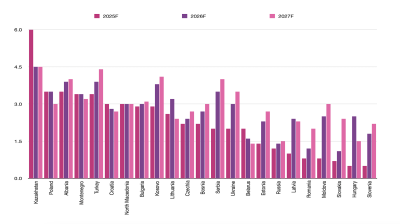There are encouraging signs that the authorities in Central Europe have brought the virus under control and policymakers are slowly starting to ease lockdown measures, which will support a recovery in activity.
It’s a different story in Russia where the number of new infections is showing no sign of slowing and the government has extended its lockdown.
Despite these differences, no economy will escape a collapse in output in Q2 and there is growing evidence that the hit to regional GDP this year will be on a similar scale to the economic fallout, which followed the collapse of communism in the early 1990s.
The number of coronavirus cases has continued to rise sharply in Russia and Turkey over the past few weeks and Turkey now has the worst outbreak in the emerging world. Meanwhile, infection curves are flattening across Central Europe and policymakers are preparing to slowly ease lockdown measures.
The latest activity data suggest that Russia’s economy weathered the coronavirus outbreak well in March. But this probably reflects the fact that the government was slow to impose lockdown measures and activity is likely to have collapsed in April. Russian financial markets have stabilised this month and this has given the central bank room to cut interest rates. We think more easing lies in store.
Turkey has the worst outbreak in the emerging world but the authorities have remained steadfast in their refusal to impose draconian lockdown measures. Even so, there are growing signs of the scale of the economic downturn. Policymakers have made a concerted effort to prop up the lira but their ability to continue to intervene is limited and efforts to compress imports are beginning to shape up.
The coronavirus outbreak and measures to slow its spread had a significant impact on Poland’s economy in March, with retail sales falling off a cliff. While the economy may have avoided a contraction in Q1, we don’t expect this to be the case in Q2 as lockdown measures bite. The government has stepped up its fiscal support and the central bank has been successful in bringing down long-term bond spreads.
Elsewhere in Central Europe, there are encouraging signs that the authorities are getting the coronavirus outbreak under control. But this has come at the expense of a collapse in activity with indicators pointing to a plunge in retail sales and industrial production in Hungary, the Czech Republic and Slovakia in April.
The region’s smaller economies such as Croatia, Bulgaria and the Baltic States have also had some success in slowing the spread of the virus and flattening infections curves. Romania’s central bank has purchased an undisclosed amount of sovereign bonds, which appears to have stabilised the bond market. Meanwhile, financial conditions have stabilised in Ukraine over the past month but there are ongoing concerns about securing a financing package from the IMF.
In financial markets, equity markets have regained some lost ground over the past month. Government bonds have rallied in Turkey and Russia, but the performance of currencies has diverged.
Coronavirus The number of confirmed coronavirus cases has continued to rise sharply in Russia and Turkey over the past few weeks and Turkey now has the worst outbreak in the emerging world. Infection curves have flattened across Central Europe, no more so than in the Czech Republic where the authorities are reporting less than 100 new cases per day (from a peak of 400 at the end of March).
Turkey and Estonia have the worst outbreaks on a per capita basis at more than 1,200 cases permn of the population. The equivalent figure for most other countries is around 500. Hungary has the highest mortality rate in the region at over 10% while it is as low as 0.9% in Russia. In Russia, as well as the Baltic States, testing has been much more prevalent than in other parts of the region.
The Czech government imposed strict lockdown measures in early March when the number of confirmed cases was low and Oxford Stringency Index suggests that the government has been easing the stringency of these restrictions more than in other parts of the world over the past month. In contrast, the Russian authorities have tightened restrictions and extended the lockdown until 11th May. These restrictions are likely to remain in place so long as the number of new virus cases remains high.
Russia
The latest activity data suggest that the coronavirus outbreak did not have a significant impact on Russia’s economy in March. Industrial production growth slowed from 3.3% y/y in February to 0.3% y/y last month. Meanwhile, retail sales growth accelerated to an eight-year high of 5.6% y/y in March. This could reflect the impact of stockpiling goods and households front-loading purchases before the effect of the fall in the ruble is passed through to prices. Indeed, a similar surge in sales happened at the end of 2014.
However, this will lay the foundations for a collapse in April. Low-profile data show that travel across major cities has slumped since the lockdown was imposed on 23rd March. The authorities are struggling to contain the outbreak with the number of cases rising by more than 6,000 per day – the fastest infection rate outside of the US. In response, the government has extended the lockdown until 11th May.
Russian financial markets have weathered the collapse in oil prices well over the past few weeks and this is mirrored in moves in dollar bond spreads, which have risen less than during previous periods of stress. This largely owes itself to the improvement in macro fundamentals in recent years. The stabilisation in financial markets, as well as growing evidence of the hit to the economy from measures to contain the virus, prompted the central bank to cut interest rates by 50bp this month and more easing lies in store.
Turkey
Turkey’s coronavirus outbreak is the worst in the emerging world, but the authorities have remained steadfast in their refusal to impose the draconian lockdown measures seen in other parts of the world. Even so, the movement of people and goods around the country has slowed sharply in recent weeks.
There are growing signs of the scale of the resulting economic downturn. April’s fall in capacity utilisation points to a 25% y/y decline in manufacturing output. And survey measures point to similar-sized falls in retail sales. In a bid to support the economy, and with inflation falling back, the central bank (CBRT) cut interest rates by 100bp, to 8.75%, this month. In order to help with financing the budget deficit, the CBRT also commenced a bond purchase programme, which has pushed down sovereign bond yields.
The lira has remained under pressure, although a concerted effort by the CBRT and state banks has prevented it falling through 7/$. But the authorities’ ability to prop up the currency is limited – short-term external debts are larger than FX reserves (18). Speculation has grown that the government will turn to the IMF but this seems highly unlikely. Instead, import compression is now being adopted – tariffs of up to 50% were introduced on a range of imports. Capital controls may soon follow.
Poland
The coronavirus outbreak and measures to slow its spread had a significant impact on Poland’s economy in March. Industrial production fell by 2.3% y/y, down from 4.8% y/y in February. In seasonally-adjusted m/m terms, output fell by 7.2%, which marked its steepest fall in more than two decades. Meanwhile, retail sales growth collapsed from 7.3% y/y in February to -9.0% y/y in March.
Sales of motor vehicles and clothing fared particularly badly while the food and pharmaceuticals sectors saw small increases in sales, presumably reflecting stockpiling. The collapse in activity came on the back of two strong months and our GDP Tracker suggests that the economy grew by 2.0-2.3% y/y in Q1.
However, the economy will contract sharply in Q2 as lockdown measures bite. Consumer confidence plunged in April to a record low. And the labour market has been hit hard, with employment falling by a record 34,000 in March. Policymakers have stepped up their aggressive response. The fiscal package amounts to around 13% of GDP. The central bank has cut interest rate by 100bp and purchased sovereign bonds worth 2.2% of GDP, which has helped to narrow bond spreads.
Czech Republic, Hungary & Slovakia
While the number of new coronavirus cases has been gradually falling across Central Europe in recent weeks and the authorities in the Czech Republic are easing some lockdown measures, the latest activity data have shown the extent of the economic fallout. Confidence indicators in Hungary and the Czech Republic plunged in April and point to retail sales contracting sharply.
The region’s industrial sectors have also been hit hard. Hungary’s manufacturing PMI plunged to a record low in March. The sharp fall in the euro-zone manufacturing PMI in April is consistent with Czech industrial production falling by an unprecedented 30% y/y in Q2. And the collapse in the German manufacturing PMI is consistent with Slovakian industrial production falling by 20% y/y in April.
Central banks have announced more measures to support the economy over the past month. The Czech MPC has now cut interest rates by a cumulative 125bp to 0.50% and we think that another 50bp lies in store in May. Meanwhile, Hungary’s central bank launched a fully-fledged quantitative easing programme to bring down long-term interest rates, which the central bank claims are too high.
Southern & Eastern Europe & The Baltic States
In the Baltic States, coronavirus outbreaks are among the worst in the emerging world on a per capita basis, but policymakers have been able to slow the spread of the virus with infection curves flattening. The latest activity data show that retail sales fell by over 6% y/y in March in Lithuania. And the plunge in the EC’s sentiment indicators for April point to sharp decline in GDP in Q2.
The EC’s measure of consumer confidence slumped across Central Europe in April but generally held up much better in Bulgaria, Romania and parts of the Baltic States. Central banks in Bulgaria and Croatia tapped euro credit lines from the ECB over the past month to increase liquidity in the financial system. Croatia’s central bank has started sovereign bond purchases, amounting to over 1% of GDP so far.
Romania’s central bank has bought an undisclosed amount of sovereign bonds and appears to have been successful in easing strains in the bond market. The pressure on Ukraine’s financial markets has eased, with dollar bond spreads falling, although they remain around 500bp higher than before the coronavirus struck as policymakers scramble to secure an $8bn financing package from the IMF.
Financial Markets
After collapsing in the second half of March, global equity markets have recovered over the past month on growing signs that the virus is being brought under control and increased policy support from governments and central banks. At a country level, most equities have risen by around 10% over the past month, although Hungary appears to be the laggard.
In the bond market, the 10-year bond yield has fallen sharply in Turkey and Russia (39), reflecting growing expectations that the Russian central bank will ease policy further and the Turkish central bank’s intervention in the sovereign bond market. That said, this masks some weakness in Turkey’s markets as CDS premia have increased by 100bp over the past month, their highest level since 2008.
Most currencies have either stabilised or gained ground over the past month. The Russian ruble is up more than 5% against the dollar despite the continued fall in the price of oil to a two-decade low. In contrast, the Turkish lira has depreciated almost 8% against the dollar and the authorities appear to be intervening in the foreign exchange market to prevent the currency slipping through 7/$.
Opinion

A year after the Novi Sad disaster, Belgrade faces one crisis after another
Serbia’s government is grappling with a convergence of crises which threaten to erode President Aleksandar Vucic’s once-dominant position.

Don’t be fooled, Northern Cyprus’ new president is no opponent of Erdogan, says academic
Turkey’s powers-that-be said to have anticipated that Tufan Erhurman will pose no major threat.

COMMENT: Hungary’s investment slump shows signs of bottoming, but EU tensions still cast a long shadow
Hungary’s economy has fallen behind its Central European peers in recent years, and the root of this underperformance lies in a sharp and protracted collapse in investment. But a possible change of government next year could change things.

IMF: Global economic outlook shows modest change amid policy shifts and complex forces
Dialing down uncertainty, reducing vulnerabilities, and investing in innovation can help deliver durable economic gains.




